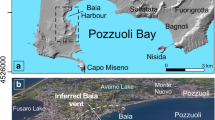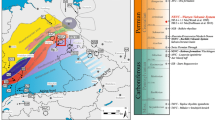Summary
Two distinct periods of volcanic activity are distinguishable at Monte Vulture volcanic complex: the first activity started with tephritic and foiditic volcanics, documented by xenoliths in the phonotrachytic (Ph-T) ignimbrites, lava blocks in a basal explosion breccia deposit beneath the Ph-T ignimbrites, sandy lenses rich in volcanic components in fluviatile conglomerates, and ended with emplacement of phonotrachytic deposits (Ph-T ignimbrites and lava domes); whereas subsequent activity produced deposits of foiditic and tephritic composition which built up the central volcano. The volcanics of the two periods do not fit a simple evolutionary model on the basis of geochemical signatures.
New whole-rock and microprobe analyses of mafic minerals from volcanics of the first period are presented here, together with the published data on M. Vulture volcanics, to give a more comprehensive picture of the magma evolution.
Principal features can be summarized as follows: (i) melanitic garnet occurs as a stable phase only in the volcanics of the first period of activity; (ii) olivine and diopside occur only in the cone building deposits; (iii) pyroxenes from the volcanics of the first stage crystallized under different physico-chemical conditions with respect to those occurring in volcanics of the central edifice; (iv) the analyzed lavas occurring as blocks in the explosion breccia deposit of the first stage display diversities with respect to the lavas of the central volcano, and it is likely that diverse parental magmas fed the first and the subsequent activities. During the first stage, crystal/liquid fractionation processes determined the evolution from the mafic parental magmas towards phonotrachytic compositions, as with the foidite-tephrtte sequence of the second stage (cone building deposits). Mineralogical evidence of mixing processes is present in the volcanics of the sequences of the two stages.
Zusammenfassung
Zwei Stadien vulkanischer Aktivität sind im Monte Vulture Komplex zu unterscheiden. Das erste Stadium ist durch tephritische und foiditische Vulkanite, die als Xenolithe in den phonotrachytischen (Ph-T) Ignimbriten erhalten sind, durch Lava Blöcke in einer basalen Explosionsbrekkzie im Liegenden der Ph-T Ignimbrite und durch Sandlinsen in fluviatilen Konglomeraten, die reich an vulkanogenen Komponenten sind, gekennzeichnet. Es endet mit der Eruption der Phontrachyte (Ph-T Ignimbrite und Lava Kuppen). Während des zweiten Stadiums wurden vulkanogene Ablagerungen foiditischer und tephritischer Zusammensetzung, die heute den Zentralteil des Vulkans aufbauen, eruptiert. Die Geochemie der Vulkanite läßt sich nicht mit Hilfe eines einfachen Bildungsmodelles erklären. Neue Gesamtgesteins- und Mikrosondenanalysen von Vulkaniten des Erststadiums und deren mafischer Minerale werden gemeinsam mit bereits publizierten Daten über die Vulkanite des Monte Vulture präsentiert, um ein zusammenfassendes Bild seiner Magmenentwicklung zu geben.
Grundsätzlich kann folgendes festgehalten werden: (i) Granat tritt als stabile Phase nur in den Vulkaniten des ersten Stadiums auf. (ii) Olivin und Diopsid sind auf die Vulkanschlote beschränkt. (iii) Die Pyroxene der Vulkanite des Frühstadiums kristallisierten unter anderem physikalisch-chemischen Bedingungen, als die im Zentralteil des Vulkans. (iv) Die untersuchten Laven, die als Blöcke in der basalen Explosionsbrekkzie auftreten, unterscheiden sich ebenfalls von denen des zentralen Teiles. Wahrscheinlich sind sie von unterschiedlichen Ausgangsmagmen abzuleiten. Durch Fraktionierung entstanden während des ersten Stadiums aus einem ursprünglich mafischen ein phonotrachytisches Magma und während des zweiten die foiditisch-tephritische Abfolge der Vulkanschlote. Hinweise auf Mischungsprozesse liegen vor.
Similar content being viewed by others
References
Balenzano F, De Marco A, Loiacono F, Scordari F (1983) Osservazioni preliminari sui caratteri sedimentologici, mineralogici e cristallo-chimici (anfiboli) dei depositi limnovulcanici del bacino di Atella (M. Vulture). Dip. Geologia e Geofisica, Università Bari, Adriatica Editrice
Barton M, Varekamp JC, van Bergen MJ (1982) Complex zoning of clinopyroxenes in the lavas of Vulsini, Latium, Italy: evidence for magma mixing. J Volcanol Geotherm Res 14: 361–388
Bence AE, Albee AL (1968) Empirical correction factors for the electron microanalysis of silicates and oxides. J Geol 76: 382–403
Crisci M, De Fino M, La Volpe L, Rapisardi L (1983) Pleistocene ignimbrites of Monte Vulture (Basilicata, Southern Italy). N Jb Geol Palaeont Mh 12: 731–746
Cundari A (1975) Mineral Chemistry and Petrogenesic aspects of the Vico lavas, Roman volcanic region, Italy. Contrib Mineral Petrol 53: 129–144
— (1982) Petrology of clinopyroxenite ejecta from Somma-Vesuvius and their genetic implications. TMPM 30: 17–35
De Fino M, Justin Visentin E (1968) II granato melanitico della fonolite di Toppo S. Paolo (Monte Vulture, Lucania). Memorie Accademia Patavina SS. LL. AA. 80: 12–20
— (1982) Magma evolution at Mount Vulture (Southern Italy). Bull Volcanol 45/2: 115–126
—, —,Peccerillo A, Piccarreta G, Poli G (1986) Petrogenesis of Monte Vulture Volcano (Italy): inferences from mineral chemistry, major and trace element data. Contrib Mineral Petrol 92: 135–145
La Volpe L, Piccarreta G (1972) Le ignimbriti del Monte Vulture (Lucania). Rendiconti Soc Ital Min Petr 28: 191–214
—,Patella D, Rapisardi L, Tramacere L (1984) The evolution of the Monte Vulture volcano (Southern Italy): inferences from volcanological, geological and deep dipole electrical soundings data. J Volcanol Geotherm Res 22: 147–162
Morimoto N, Fabries J, Ferguson AK, Ginzburg IV, Ross M, Seifert FA, Zussman J, Aoki K, Gottardi G (1988) Nomenclature of Pyroxenes. Mineral Petrol 39: 55–76
Nisbet EG, Pearce JC (1977) Clinopyroxene composition in mafic lavas from different tectonic setting. Contrib Mineral Petrol 63: 149–160
Rahman S (1975) Some aluminous clinopyroxenes from Vesuvius and Monte Somma, Italy. Mineral Mag 40: 43–52
Roeder PL, Emslie RF (1970) Olivine-liquid equilibrium. Contrib Mineral Petrol 29:275–289
Thompson RN (1972) Oscillatory and sector zoning in augite from a Vesuvian lava. Carnegie Inst Washington Yearb 71: 463–470
Villemant B;Jaffrezic H, Joron JL, Treuil N (1981) Distribution coefficients of major and trace elements; fractional crystallization in the alkali basalt series of chain des Puys (Massif Central, France). Geochim Cosmochim Acta 40: 283–295
Author information
Authors and Affiliations
Additional information
With 6 Figures
Rights and permissions
About this article
Cite this article
Caggianelli, A., De Fino, M., La Volpe, L. et al. Mineral chemistry of Monte Vulture volcanics: petrological implications. Mineralogy and Petrology 41, 215–227 (1990). https://doi.org/10.1007/BF01168496
Received:
Accepted:
Issue Date:
DOI: https://doi.org/10.1007/BF01168496




